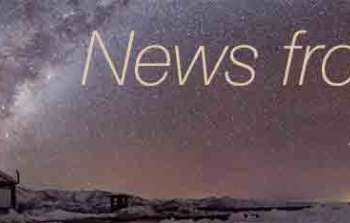sci19036 — Announcement
First Night of AEON Queue Operations on SOAR a Success!
August 18, 2019
Cesar Briceno, Jay Elias (NOAO)
The Astronomical Event Observatory Network (AEON), a collaboration between Las Cumbres Observatory (LCOGT), NOAO, SOAR and Gemini, is aimed at building an ecosystem of world-class telescope facilities for the follow up of transients and time-domain astronomy, in preparation for the LSST era.
The night of 6 August 2019 set a milestone for the project, as the first of 20 nights scheduled on the SOAR telescope this semester in AEON-queue mode. The night was successful, with a total of 10 different targets studied under excellent observing conditions. Additional queue-scheduled observing nights are anticipated at a rate of 3-4 per month for the remainder of the 2019B semester.
Over this semester, SOAR’s AEON-scheduled queue will carry out observations that have been approved through the standard NOAO TAC process. The approved programs, eight regular programs and four Target-of-Opportunity programs, pursue diverse science cases, ranging from the characterization and study of Near Earth Objects, microlensing events, young supernovae, RR Lyrae stars in ultra-faint dwarf galaxies, solar-like pre-main sequence stars, to the follow up of Galactic transients and gravitational wave events.
AEON builds on the infrastructure of the existing network of small telescopes run by LCOGT to incorporate 4-m and 8-m class telescopes. The underlying idea is to create an integrated “follow-up” ecosystem, as outlined in the figure below.
The AEON concept. The red rectangle on the right highlights the portions currently under development and testing. SOAR is the pathfinder facility for bringing other telescopes into a highly automated system, running unsupervised software, that generates a dynamic and flexible schedule roughly every 15 minutes.
SOAR’s Goodman instrument is currently available through the AEON queue in a subset of modes: imaging with the VR, SDSS-g, SDSS-r, SDSS-i filters, and spectroscopy with the red camera, 400 line grating and 1 arcsecond slit. Users can submit their targets at any time during the semester, through the LCOGT Observing Portal or with custom software that connects to LCOGT via their API. On an AEON night, the observing schedule is downloaded from LCOGT and executed by software that runs both the telescope and the Goodman instrument; guide star and on-slit target acquisition (for spectroscopic observations) are the only steps still carried out manually. Users can obtain the status of their observations and retrieve their raw data through the LCOGT Observing Portal. Data reduction can be carried out in an automated way using the Goodman Spectroscopic Data Reduction Pipeline. Further information on observing with AEON is available at the LCOGT-AEON web site.
SOAR intends to expand the range of Goodman configurations available in queue mode and to eventually add additional instruments such as TripleSpec 4.1. The underlying objective is to provide flexible observing in an era of complex observing requirements ranging from large survey programs to focused time-domain programs.
To learn more: Interested SOAR-AEON users, including those affiliated with other SOAR partners, are invited to consult future issues of Currents and calls for the proposals for additional opportunities and information. Updates on available instruments or observing configurations for the 2020A semester will be provided when the NOAO call for proposals is issued in early September. We are also very much interested in including programs from other SOAR partners in the AEON queue. Developing the AEON Network will be a major topic of discussion at the upcoming TOM Toolkit Workshop (see related article below). Further information on the current status and related matters at the SOAR AEON page.
SOAR’s success in reaching this milestone is due to the effort of a many people, including Diego Gomez and Omar Estay of NOAO and Jon Nation, Elizabeth Heinrich, and Mark Bowman of Las Cumbres Observatory. Queue operations also rely on the skill and efficiency of the regular SOAR operators. Funding for much of this work was provided by supplementary funding from the National Science Foundation.
(An earlier version of this story referred to Las Cumbres Observatory by the acronym LCO. This has been updated to LCOGT to avoid confusion with Las Campanas Observatory.)
About the Announcement
| Id: |
ID
sci19036
|

